Well, it took patience, but some thirty-odd extrasolar planets have finally been given proper, human-readable names.
The names are as follows:
Epsilon Tauri (Ain) - Amateru
Iota Draconis (Edasich) - Hypatia
Gamma Cephei (Errai) - Tadmor
Fomalhaut - Dagon
Pollux - Thestias
Epsilon Eridani (Ran) - AEgir
Mu Arae (Cervantes) - Quijote, Dulcinea, Rocinante, Sancho
Upsilon Andromedae (Titawin) - Saffar, Samh, Majriti
Xi Aquilae (Libertas) - Fortitudo
14 Andromedae (Veritate) - Spe
18 Delphini (Musica) - Arion
42 Draconis (Fafnir) - Orbitar
47 Ursae Majoris (Chalawan) - Taphao Thong, Taphao Kaew
51 Pegasi (Helvetios) - Dimidium
55 Cancri (Copernicus) - Galileo, Brahe, Lippershey, Janssen, Harriot
HD 81688 (Intercrus) - Arkas
HD 104985 (Tonatiuh) - Meztli
HD 149026 (Ogma) - Smertrios
PSR 1257+12B (Lich) - Draugr, Poltergeist, Phobetor
Here, for convenience's sake, are the names I voted for:
Ain/Epsilon Tauri - Namida
Edasich/Iota Draconis - Foros
Errai/Gamma Cephei - Kharoof
Fomalhaut - Labroides
Pollux - Leda
Epsilon Eridani - Ran, Aegir
Mu Arae - Lusitania, Caravela, Adamastor, Esperanca, Saudade
Tau Bootis - Asuka, Kitora
Upsilon Andromedae - Rayeta, Moltina, Dolasilla, Luyanta
Xi Aquilae - Gobidin, Ewinon
14 Andromedae - Gwendolen, Hafren
18 Delphini - Arion, Koto
42 Draconis - Victor, Byurakan
47 Ursae Majoris - Atsuta, Miyasuhime, Shirotori
51 Pegasi - Helvetios, Dimidium
55 Cancri - Scyllae, Tachypleus, Birgus, Lithodes, Uca
HD 81688 - Kimunkamuy, Heper
HD 104985 - Goban, Fuseki
HD 149026 - Opuntia, Cycla
PSR 1257+12B - Lich, Draugr, Poltergeist, Phobetor
Ultimately, my votes didn't match up with the results that closely. Yet I'm not nearly as disappointed at that occurrence as I would've expected in this scenario. Despite a lot of silly names being proposed, the end results are actually quite agreeable for me.
Some observations:
-Lich and its accompanying planets are the ones I most wanted to see named what they did. Possibly because someone put real effort into finding a common theme to the names that also tied into the nature of these planets - in this case, planets orbiting an "undead" star.
-It's a real shame we won't be calling 51 Pegasi b "Bellerophon" anymore, most likely due to a technicality. I get that scientific names should be unambiguous, but science should also be accessible to the layman. I don't think it's unreasonable to reuse minor planet names for extrasolar planets. Still, I'm grateful for the consolation that my vote won.
-"Orbitar" is basically a made-up word. I should be grateful it appears to be the only such name to win.
-"AEgir", with the capital E, is not a typo. Apparently "Aegir" refers to a moon of Saturn but "AEgir" refers to the exoplanet. So if we called 51 Pegasi b "BEllerophon", would that make you happy, IAU?
-For reasons unknown, the IAU refrained from giving a name to Tau Bootis b. It will probably get a do-over vote next time a vote is held.
All in all, I am very excited about what this vote represents. It may not seem like much to name planets we know next to nothing about, but the fact of the matter is, we know about as much about these planets as astronomers of centuries past knew about the planets in our solar system. In a way, we are living out a new astronomical age of discovery.
This initiative to name new planets could change our view of the universe. Stars in our galaxy, though far, far, away, hopefully will no longer be seen as abstract concepts but as real locations to be visited one day. I hope that the enthusiasm for exoplanetology will increase. I'm filled with new hope that giving these planets proper names will forcefully awaken a paradigm shift in how people view the universe.
I feel like there's something else I should be doing this weekend...
Saturday, December 19, 2015
Saturday, November 14, 2015
On Solar Systems
I've talked about mapping the galaxy creatively before, and the focus of this entire blog is creatively realizing planets. Between those two tiers of worldbuilding, though, is the structure that forms the foundation of our understanding of outer space: the solar system. (Just FYI: when I refer to a "solar system" without capitalization, I'm referring to any system of stars and planets. When I capitalize "Solar System", I'm referring to ours. I believe a "star system" would technically refer to systems containing more than one star, with at least one orbiting the other.)
Now, when students are first taught about space, whether it's through primary school, picture books, or The Magic School Bus, they're usually taught about the eight or nine planets, in order.
 |
| Thus perpetuating the erroneous notion that they are always aligned in a neat little row. (Source) |
Supplemental material to movies and TV, on the other hand, seem more open to this kind of worldbuilding, though in reference books like the Star Wars Essential Atlas, it basically comes down to grabbing a handful of Scrabble tiles at random, throwing them onto the desk, and then rearranging them into something remotely pronounceable, accompanied by a terse description like "gas giant" or "airless rock".
For some reason though, seems like supplements to TV shows do solar systems better than other media.
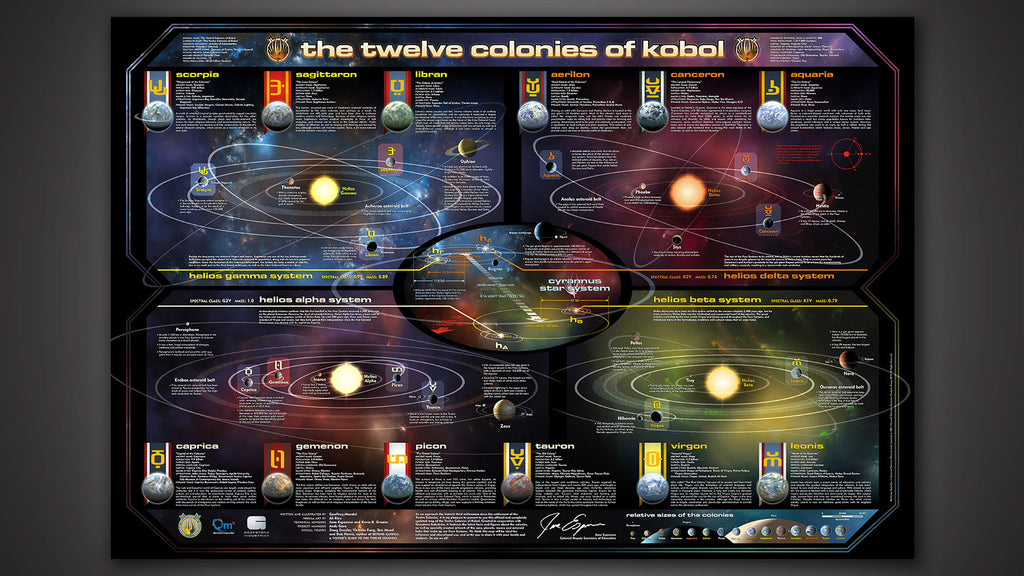 |
| (Source) |
This map, which you can explore in greater detail at the accompanying link, fleshes out those twelve worlds, and makes their destruction hit you all the harder because they're just so cool.
I talk a lot about variety and creativity when discussing alien worlds, but I like the approach taken to the twelve colony planets in this map. They're all distinctive in appearance, but they all adhere to largely the same color palette; they're not so much "alien planets" as they are "parallel Earths". The end result strikes a perfect balance between diversity and thematic consistency. The other planets, the gas giants and airless rocks, aren't important, but still get some flavor text.
I also love the setup of a quaternary star system, or a "binary binary," if you will. One could at least infer from the original version, and the remake made it explicit, that the Colonials had FTL. Yet in celestial terms, these planets are all still within spitting distance of each other. While it's unlikely that any star system could just happen to have twelve human-habitable worlds naturally - without terraforming, that's far from the least plausible thing in the franchise.
Predating the Battlestar Galactica map, yet taking its concept to the nth degree, is Firefly's "Complete and Official Map of the Verse."
 |
| Dun da-da-DAAAA!!! (Source) |
Follow the source links and you can take a much closer look at both maps. You can also explore the Firefly Verse with this app, though you will have to pay $4.99 as an in-app purchase to view the actual map.
I think I like these solar systems because they're so unconventional. Instead of just having a row of planets orbiting one star, we have a system that necessitates a map; simply listing the planets would be insufficient. Maybe it's the fact that these multiple-star systems seem more...asymmetrical than the typical solar system, granting a greater sense of realism to the fictitious universes? Or maybe it's just the complexity. Or all of the above.
There's really not a single configuration of planets or moons I can think of (and if I'm wrong, let me know) that isn't represented in one of these two maps. We have binary stars, binary planets (Caprica and Gemenon), planets sharing an orbit in each other's Lagrangian points (Angel and Zephyr), planets with rings, moons with rings, and - since some of these stars were once planets - moons of moons!
Now, it's not likely for moons to have moons of their own. Natural satellites tend to have smaller Hill spheres, or areas of gravitational dominance, so the existence of a parent planet makes any moons of those moons have unstable and thus ephemeral orbits. However, the universe is a vast place. So if we ever do find a moon that has a moon of its own moon moon moon moooooooooooooooooooooon...
Excuse me.
We need a term for a moon's moon. I propose the term "metamoon." The Greek prefix "meta-", meaning "after" or "beyond" seems fitting to denote a new tier of satellite. Planets orbit stars, moons orbit planets, and metamoons orbit moons. Also, we often associate the prefix with the idea of recursion, as in "metacognition" (thinking about thinking) or "metafiction" (fiction about fiction). So a metamoon is a moon of a moon. Moooooon.
Of course, not all sci-fi solar systems need to be this complex. I'd just be happy to know how many moons a planet has and what their names are. It's just that attention to detail that makes the work's universe so intriguing.
Also, if you're going to construct a solar system, try to follow a theme when naming the planets, like how the planets in our own Solar System are named from Roman mythology. The Twelve Colonies all are named for the Zodiac. Rodina uses Slavic mythology.
As a last note, here's a solar system I whipped up in MS Paint as my friend and I were trading story ideas. Note the theme of Arthurian legend figures I use here. And also note that I use the terms "whipped up" and "MS Paint" to explain why it's so crude:
Saturday, October 31, 2015
Happy Halloween
I suppose I should come up with something extra-scary to talk about on Halloween. Well, after a month of monster haikus, there's not much I can think of right now.
Except this: today marks the last day voting is open for naming those 20 exoplanets I was talking about before. The winners will be announced any day now. And if that isn't scary, I don't know what is.
 |
| Happy Halloween from the IAU! |
Tuesday, October 6, 2015
Alien-tober Month-Long Monster Mash!
The Gist: In the spirit of Halloween, every day for the month of October I will spotlight some alien monster from science fiction. But before you start cheering because you think you'll be getting seven times the blogging out of me, let me qualify that. Since I work full-time, and because I like sleeping, I will not be giving a detailed analysis every day but instead offer a haiku. Check back at this post every day for updates!
I will accept suggestions for consideration in the comments, but bear in mind I generally restrict my blog topics to sci-fi works I am familiar with.
Without further adieu...
Oct 1
Headcrab (Half-Life)

Discount Facehugger
Is Ridley Scott gonna sue?
I like this thing more.
Oct 2
Slitheen/Raxacoricofallapatorian (Doctor Who)

Calcium-based life
I've heard of alternate chem...
But that's a new one.
Oct 3
Tholian (Star Trek)
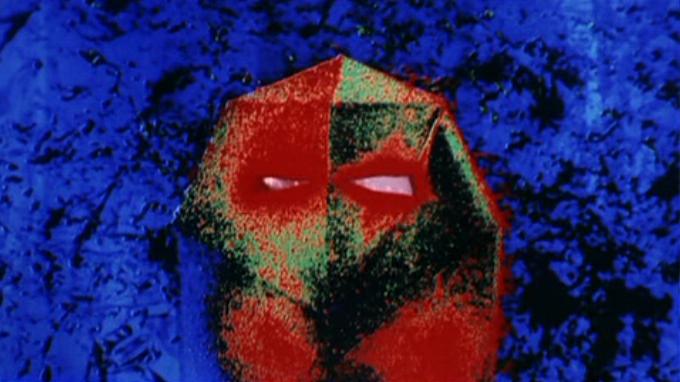
Sixties effects, but...
Quintessential example
Of silicon life
Oct 4
Sarlacc (Star Wars)
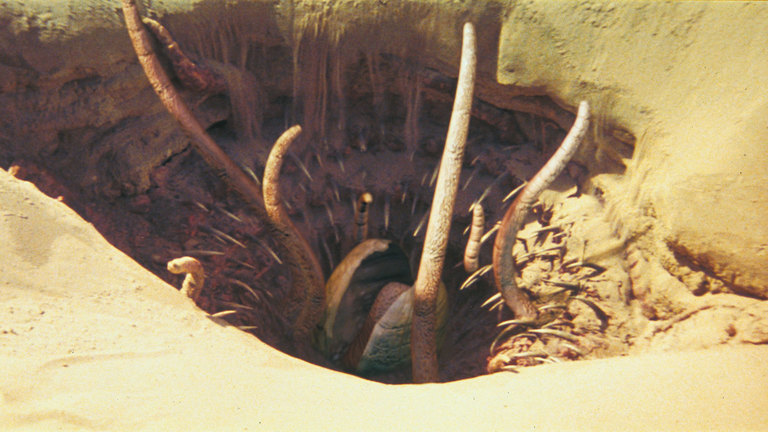
Plant-animal blend
But sends seeds to new planets?
That's just ludicrous.
Oct 5
Black Beast of Aaaaaaaaargh (Monty Python and the Holy Grail)

Cartoon peril, yes
But lots of eyes, just two legs.
A bit top-heavy.
Oct 6
Chryssalid (XCOM: Enemy Unknown)

Giant bugs are cool
But the zombie element?
Done to death so much.
Oct 7
Great Leonopteryx (James Cameron's Avatar)
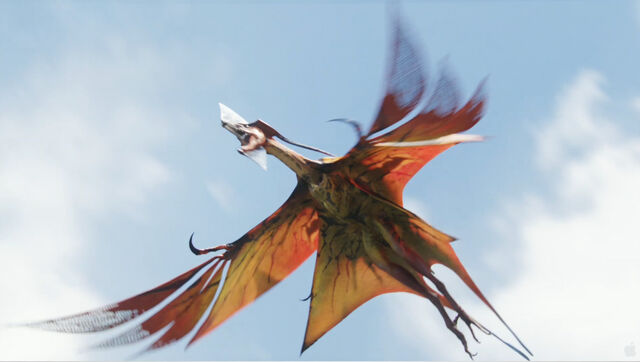
Made of raw awesome
Apex predator, colors,
Who wouldn't want one?
Oct 8
Shoggoth (Cthulhu Mythos)
Gooey body form
More eyes than necessary
What holds this thing up?
Oct 9
Thresher Maw (Mass Effect)
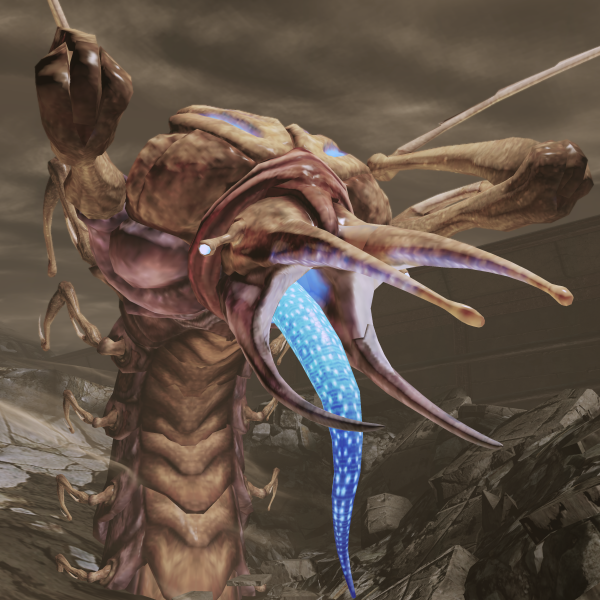
Sandworm meets Sarlacc
Supposedly a big threat
Too easy to kill
Oct 10
Horta (Star Trek)

Monster is a mom
No eyes, yet likes Vulcan ears?
Silicon node eggs.
Oct 11
Dalek (Doctor Who)

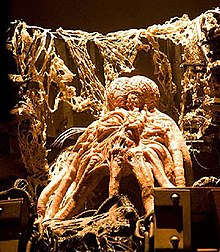
One-eyed mutant squid
Looks like H.G. Wells's Martian
Cry EXTERMINATE!!!
Oct 12
Metroid (Metroid)
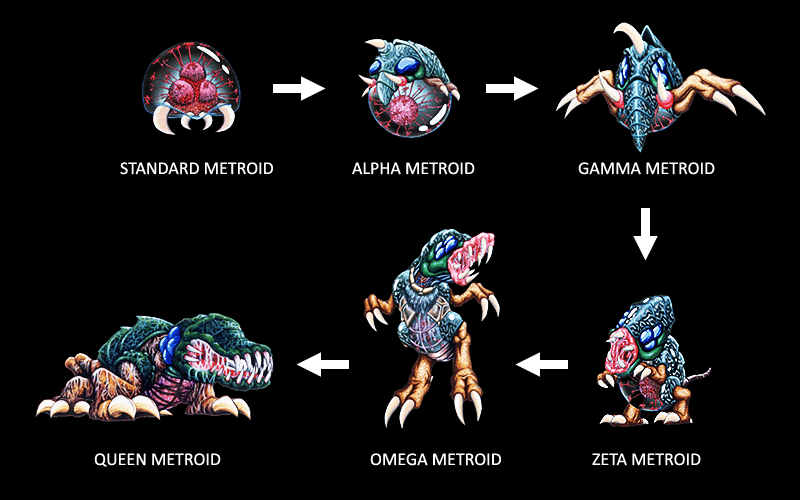
Floating jellyfish
Sucks the life right out of you
Complex life cycle
Oct 13
Dimorphodon (Jurassic World...and, uh, real life...)
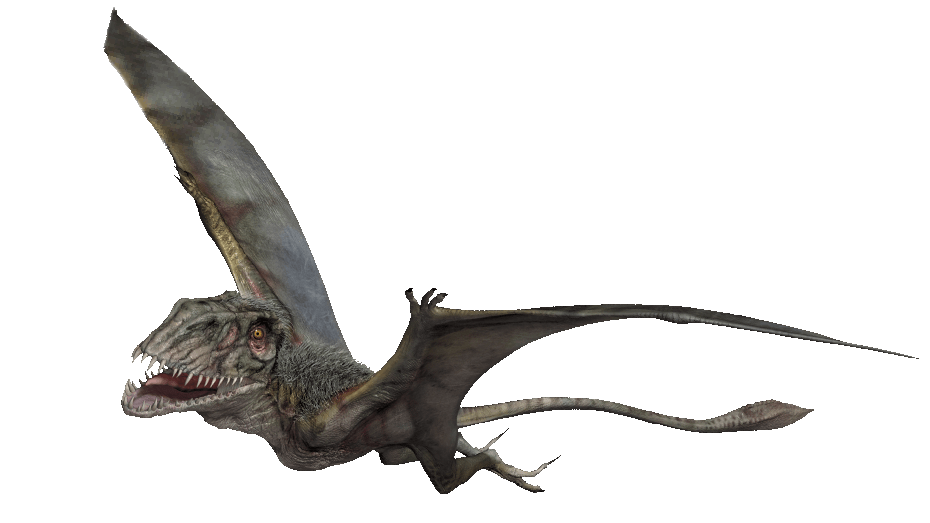
That oversized head...
So terrifyingly wrong.
Quick! Kill it with fire!
Oct 14
Ravenous Bugblatter Beast of Traal (The Hitchhiker's Guide to the Galaxy)
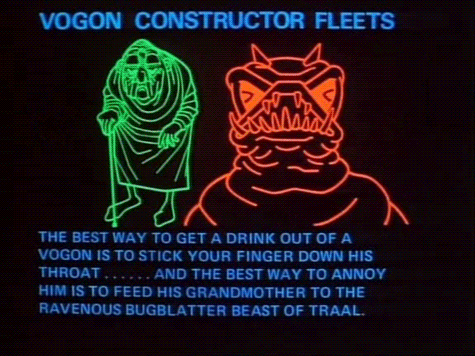
Super-predator
Actually dumb as rock
Keep a towel close
Oct 15
Moldorm (Legend of Zelda)

Tough-skinned desert slug
Another sandworm creature
Only much smaller
Oct 16
Otachi (Pacific Rim)

Acid spit and wings
Can lift a Jaeger with claws
Must be super strong
Oct 17
Predator (Predator)
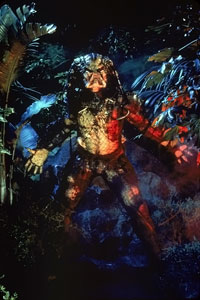
Permanent dreadlocks
With quad-mandible mouth shape
And very sneaky
Oct 18
Xenomorph (Alien)

Obligatory
Acid blood? Are you kidding?
I am not a fan
Oct 19
Elder Thing (Cthulhu Mythos)
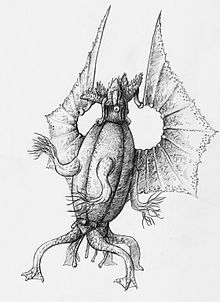
Wings? Solar sails!
Weird radial symmetry
Tentacle fingers?
Oct 20
Pig-lizard (Galaxy Quest)

Two legs, and no arms
No neck to break, falling down
What is his diet?
Oct 21
Cave-Troll (The Lord of the Rings)

Man-shaped, but more beast
Berserker brute, watch your back
Where does he get food?
Oct 22
Vortigaunt (Half-Life)

Third arm, proboscis?
Can shoot electricity
Friendly in sequel
Oct 23
MUTOs (Godzilla)
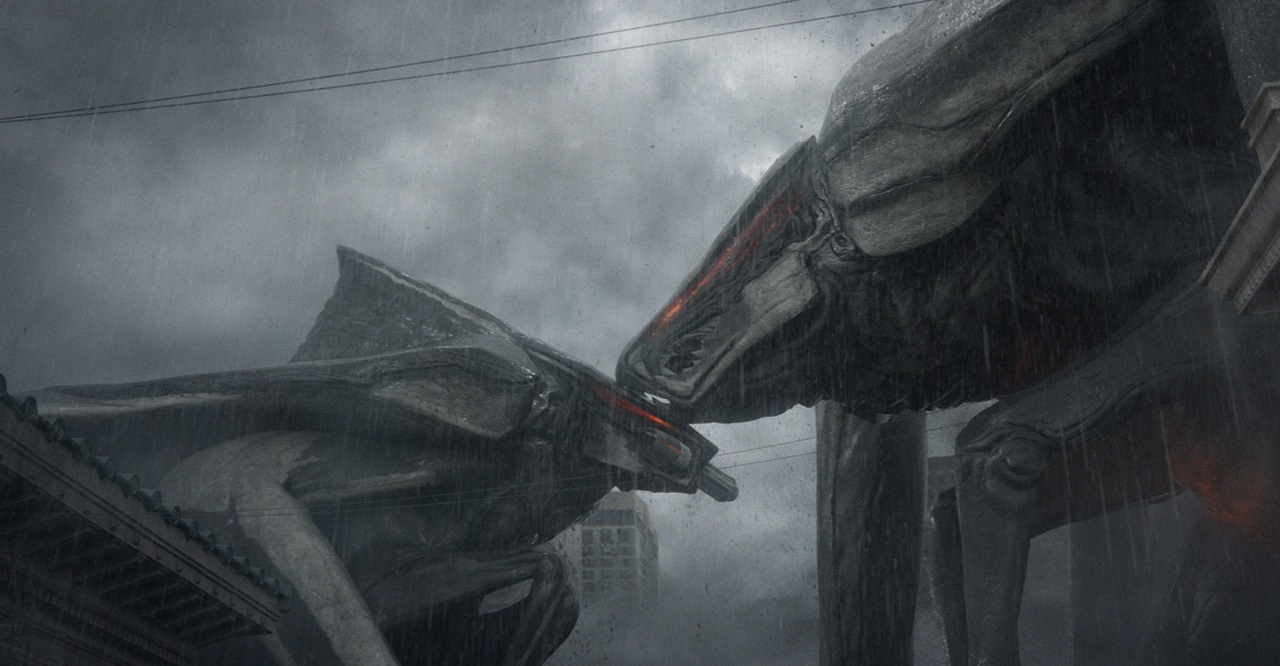
Glowing eyes? How so?
Feeding on radiation
Lots and lots of eggs
Oct 24
Colo Claw Fish (Star Wars)
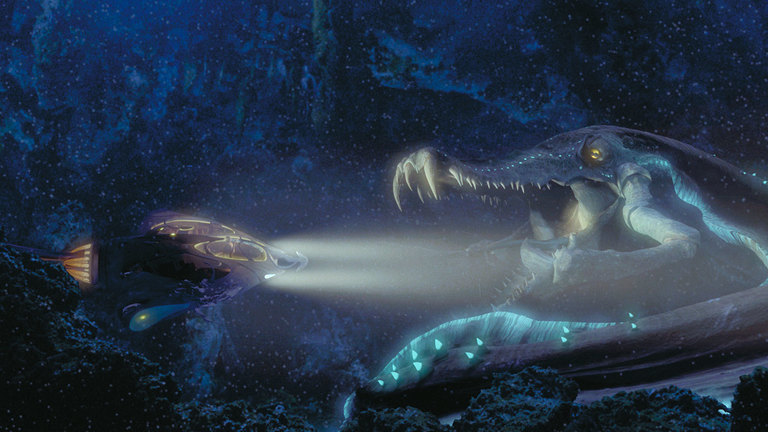
Big fish with two arms
Yet not apex predator
Always bigger fish
Oct 25
Octorok (Legend of Zelda)

Four-tentacled bod
Spits boulders from the shallows
Where'd he get the rocks?
Oct 26
Vermicious Knid (Charlie and the Great Glass Elevator)
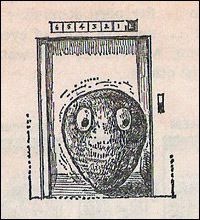
Shapeshifting green blob
Can survive in outer space
Burns in re-entry
Oct 27
Judoon (Doctor Who)
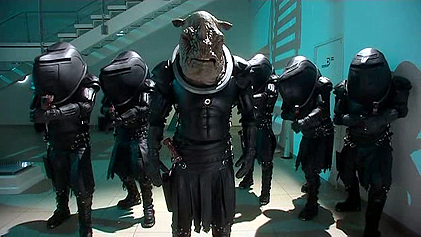
Big head; top-heavy?
If Judge Dredd were a rhino
This is how he'd look
Oct 28
Varren (Mass Effect)
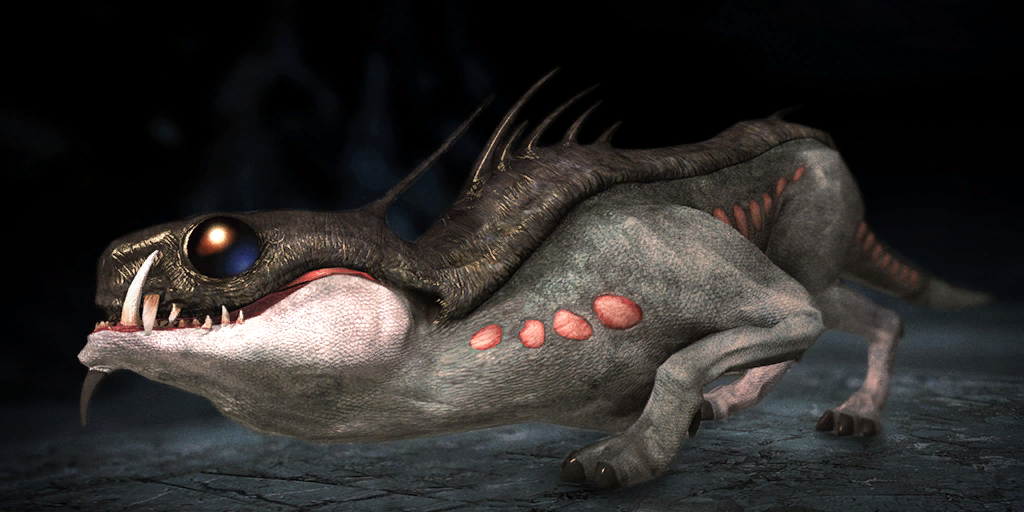
Alien dog-fish
Neat, but a tad generic
Domesticable!
Oct 29
Space Slug (Star Wars)

Just what's he made of?
And just what does this guy eat?
So many questions...
Oct 30
Hengrauggi (Star Trek - 2009 film)
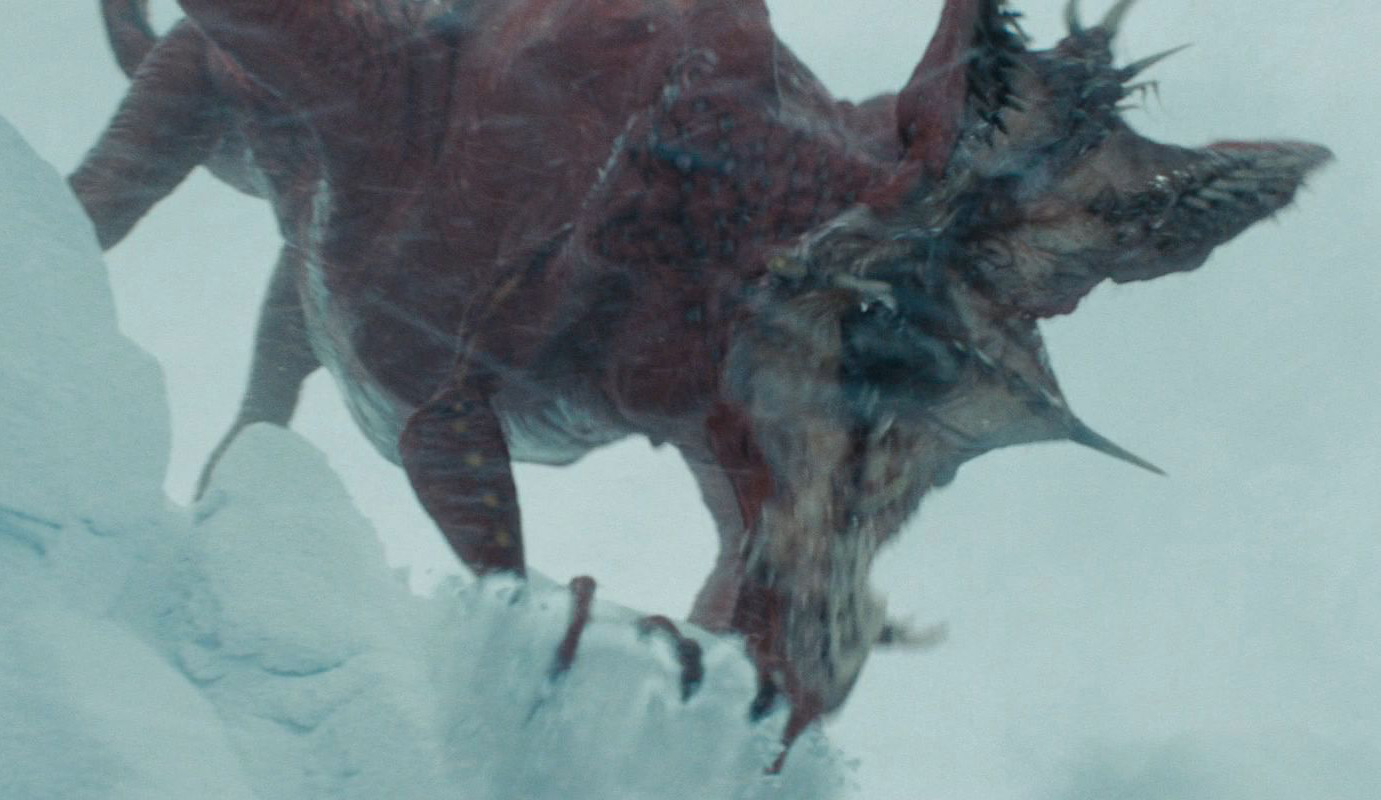
Bright red like lobster
Scary mouth and scary tongue
How'd he break the ice?
Oct 31
Cthulhu (Cthulhu Mythos...duh...)

(Source)
Wings? Underwater?
Pioneered tentacle beards.
Weak to ramming ships.
I will accept suggestions for consideration in the comments, but bear in mind I generally restrict my blog topics to sci-fi works I am familiar with.
Without further adieu...
Oct 1
Headcrab (Half-Life)

Discount Facehugger
Is Ridley Scott gonna sue?
I like this thing more.
Oct 2
Slitheen/Raxacoricofallapatorian (Doctor Who)

Calcium-based life
I've heard of alternate chem...
But that's a new one.
Oct 3
Tholian (Star Trek)

Sixties effects, but...
Quintessential example
Of silicon life
Oct 4
Sarlacc (Star Wars)

Plant-animal blend
But sends seeds to new planets?
That's just ludicrous.
Oct 5
Black Beast of Aaaaaaaaargh (Monty Python and the Holy Grail)

Cartoon peril, yes
But lots of eyes, just two legs.
A bit top-heavy.
Oct 6
Chryssalid (XCOM: Enemy Unknown)

Giant bugs are cool
But the zombie element?
Done to death so much.
Oct 7
Great Leonopteryx (James Cameron's Avatar)
Made of raw awesome
Apex predator, colors,
Who wouldn't want one?
Oct 8
Shoggoth (Cthulhu Mythos)
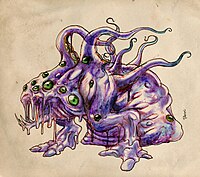 |
| Source |
Gooey body form
More eyes than necessary
What holds this thing up?
Oct 9
Thresher Maw (Mass Effect)

Sandworm meets Sarlacc
Supposedly a big threat
Too easy to kill
Oct 10
Horta (Star Trek)

Monster is a mom
No eyes, yet likes Vulcan ears?
Silicon node eggs.
Oct 11
Dalek (Doctor Who)


One-eyed mutant squid
Looks like H.G. Wells's Martian
Cry EXTERMINATE!!!
Oct 12
Metroid (Metroid)

Floating jellyfish
Sucks the life right out of you
Complex life cycle
Oct 13
Dimorphodon (Jurassic World...and, uh, real life...)

That oversized head...
So terrifyingly wrong.
Quick! Kill it with fire!
Oct 14
Ravenous Bugblatter Beast of Traal (The Hitchhiker's Guide to the Galaxy)

Super-predator
Actually dumb as rock
Keep a towel close
Oct 15
Moldorm (Legend of Zelda)

Tough-skinned desert slug
Another sandworm creature
Only much smaller
Oct 16
Otachi (Pacific Rim)

Acid spit and wings
Can lift a Jaeger with claws
Must be super strong
Oct 17
Predator (Predator)

Permanent dreadlocks
With quad-mandible mouth shape
And very sneaky
Oct 18
Xenomorph (Alien)

Obligatory
Acid blood? Are you kidding?
I am not a fan
Oct 19
Elder Thing (Cthulhu Mythos)

Wings? Solar sails!
Weird radial symmetry
Tentacle fingers?
Oct 20
Pig-lizard (Galaxy Quest)

Two legs, and no arms
No neck to break, falling down
What is his diet?
Oct 21
Cave-Troll (The Lord of the Rings)

Man-shaped, but more beast
Berserker brute, watch your back
Where does he get food?
Oct 22
Vortigaunt (Half-Life)

Third arm, proboscis?
Can shoot electricity
Friendly in sequel
Oct 23
MUTOs (Godzilla)

Glowing eyes? How so?
Feeding on radiation
Lots and lots of eggs
Oct 24
Colo Claw Fish (Star Wars)

Big fish with two arms
Yet not apex predator
Always bigger fish
Oct 25
Octorok (Legend of Zelda)

Four-tentacled bod
Spits boulders from the shallows
Where'd he get the rocks?
Oct 26
Vermicious Knid (Charlie and the Great Glass Elevator)

Shapeshifting green blob
Can survive in outer space
Burns in re-entry
Oct 27
Judoon (Doctor Who)

Big head; top-heavy?
If Judge Dredd were a rhino
This is how he'd look
Oct 28
Varren (Mass Effect)

Alien dog-fish
Neat, but a tad generic
Domesticable!
Oct 29
Space Slug (Star Wars)

Just what's he made of?
And just what does this guy eat?
So many questions...
Oct 30
Hengrauggi (Star Trek - 2009 film)

Bright red like lobster
Scary mouth and scary tongue
How'd he break the ice?
Oct 31
Cthulhu (Cthulhu Mythos...duh...)

(Source)
Wings? Underwater?
Pioneered tentacle beards.
Weak to ramming ships.
Monday, October 5, 2015
"The Martian" Proves Me Wrong
"There is a theory which states that the universe is built on uncertainty and that a definitive statement/action creates a momentary energy vacuum into which flows a diametrically opposing statement/action. Famous vacuum-inducing statements include: 'Surely that's not going to fit in there.' 'I am sick of betting the same numbers every week. They are never going to come up.' 'We are a peaceful people. Not even the Armorfiends of Striterax would want to pick a fight with us.' 'You look gorgeous in that sweater, Felix. There is no way anyone is going to call you a freak and throw you in a dumple composter.'"
-Eoin Colfer, And Another Thing...
I guess that's what happened after I said that Mars is boring. It took its sweet time coming back to bite me, but bite me it did. First we find out there's actual, flowing water on Mars, and then less than a week later The Martian comes out and makes me fall in love with the Red Planet. And yes, SPOILERS FOLLOW.


Based on the novel by webcomic artist Andy Weir, The Martian is only the second movie in the space of a year to feature Matt Damon stuck on another planet. And despite my growing love of Christopher Nolan's Interstellar, I actually think The Martian may be a better movie. It doesn't take itself too seriously, it's even "harder" sci-fi than Nolan's movie, and perhaps most importantly, levity is in no short supply. Also, there is so much clever MacGyvering in this movie.
I saw this movie in 3D and for once, I'm glad I did. I've seen my fair share of movies in 3D but only because the showtime was convenient; the only thing I resent more than shelling out $14 for a two-hour movie is being assaulted with nightmare-fuel-loaded horror trailers in the pre-show when all I wanted was to see Matt Damon stuck on Mars (hey guys, PG-13 is not an invitation for you to induce night terrors). But I digress...
This movie benefits from the 3D because of all the long shots of the Martian landscape (Acidalia Planitia, to be specific). And what a landscape it is!
| Source: comingsoon.net |
The backgrounds are just beautiful; they remind me of the planets that Spaceman Spiff would often crash into (Bill Watterson was a pro at that). The landscapes are often dynamic with dust clouds racing by in the yellow-gray sky or even dust devils spinning around (and yes, those do really happen on Mars).
The view of one of Mars's moons does crop up in a few shots too. I'm assuming it's Phobos because it's much closer to the planet and therefore a lot bigger. It didn't appear to be moving visibly in the sky though, which may make sense because the shots only last a few seconds. In reality though, Phobos takes less than eight hours to orbit the planet. When you compare that to the 28 days it takes our moon to orbit, that's pretty impressive.
 |
| Phobos transiting Deimos as seen from the Curiosity rover - in real time. |
Also, apparently there is evidence that the planet's soil contains toxic metals like arsenic and something called hexavalent chromium. This is never addressed when Damon's character uses Martian soil to grow his potato plants. Now I don't know what kinds of concentrations are in the soil, or whether it finds its way into the potatoes and thus into Matt Damon. Even then, exposure to carcinogens does not automatically equal a guarantee of cancer. Still, I'd have liked to see it addressed. Maybe it's discussed in the novel, which I haven't read yet (though it is at the top of my list). Still, when you consider that Interstellar presented frozen clouds, these are minor quibbles.
This is a movie worth seeing. It's worth seeing in 3D. See Mars like you've never seen it before.
| Source: wallpapershome.com |
I was wrong. Mars is awesome.
Subscribe to:
Posts (Atom)


